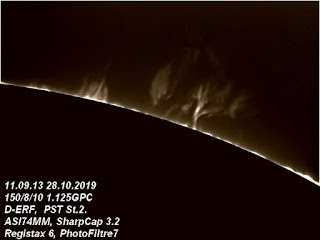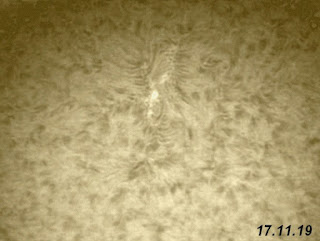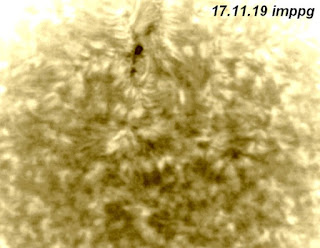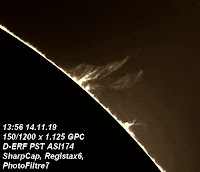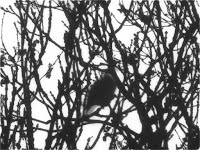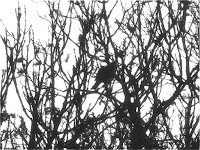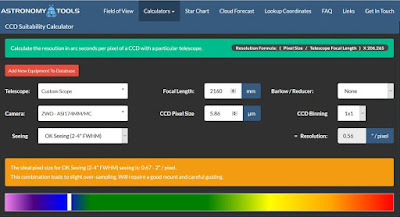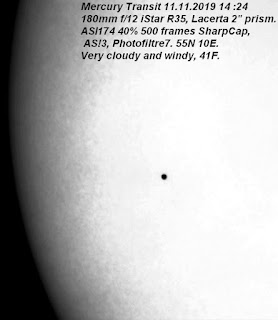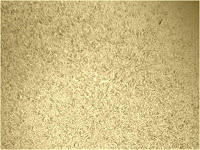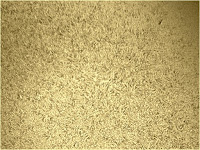*
Saturday 30th Nov. 34F. -2C white frost overnight. Almost clear sky at
10am as the last of the frost melts off the top of the dome in bright
sunlight. Just checked Stellarium and the sun doesn't get above 13°
today.
10.40, 37F and I am all set up with the sun looking crisp in H-a on the screen. Everything is covered in dew. A neighbour's birch has just grown into my field of view! Grr?
Skiing trousers, two thick jumpers, thermal vest, t-shirt and duvet jacket. I'm wearing my walking boots over thick, loop pile socks to try to keep my feet warm. Baseball cap [for the peak] under a fur lined, trapper's hat.
Horribly asymmetrical variation of brightness across the field of view. I have the etalon fully turned one way. I ought to try moving the screw to another hole on the etalon. Not much difference. Then try the tilt plates. See SharpCap 'snap' on the right.
Whoops! I just checked the 6" objective. Solid dew! It's no wonder I have light and shadows on the image! I can't reach to see into the dewshield so I used a compact mirror instead. Will it clear at 36F in the dome? I don't have a hair drier. It is odd how sharp the surface texture looks despite a full aperture covering of dew. The 7" is covered in droplets so is even worse! I am losing valuable sun time with probably the best seeing of the day.
I haven't been using any objective lens covers so far. The telescopes obviously became chilled overnight. Opening the dome to the sun raises the air temperature above the dew point. While the massive lumps of glass are lagging badly behind. I have now wrapped the 6" cell and dewshield in thick, closed cell foam to try and speed up the drying process. There is a clear crescent of glass now.
Then it clouded over so I went shopping. I am now the proud owner of a recycled Braun Mini hairdrier. £2.50 equivalent from the charity shop. The cloud has cleared as I enjoy lunch. So I shall be back out there ASAP.
Sun lost behind the roof. Slewed to the Moon with the 7" but it is getting cloudy again. Eventually the cloud cleared and I captured lots of overlapping ideos of the moon with the ASI174. The idea was to process them and then let ICE stitch them together. Getting 200fps! The downside was the poor seeing conditions. Soft, with special "thermal" effects racing across the image on the screen. The moon was just above the ridge of the roof and the woodstove was lit. Hardly surprising the moon was mush.
I have capped both lenses and wrapped the upper OTAs and cells in closed cell foam, camping mattress material. Only -1C forecast.
10.40, 37F and I am all set up with the sun looking crisp in H-a on the screen. Everything is covered in dew. A neighbour's birch has just grown into my field of view! Grr?
Skiing trousers, two thick jumpers, thermal vest, t-shirt and duvet jacket. I'm wearing my walking boots over thick, loop pile socks to try to keep my feet warm. Baseball cap [for the peak] under a fur lined, trapper's hat.
Horribly asymmetrical variation of brightness across the field of view. I have the etalon fully turned one way. I ought to try moving the screw to another hole on the etalon. Not much difference. Then try the tilt plates. See SharpCap 'snap' on the right.
Whoops! I just checked the 6" objective. Solid dew! It's no wonder I have light and shadows on the image! I can't reach to see into the dewshield so I used a compact mirror instead. Will it clear at 36F in the dome? I don't have a hair drier. It is odd how sharp the surface texture looks despite a full aperture covering of dew. The 7" is covered in droplets so is even worse! I am losing valuable sun time with probably the best seeing of the day.
I haven't been using any objective lens covers so far. The telescopes obviously became chilled overnight. Opening the dome to the sun raises the air temperature above the dew point. While the massive lumps of glass are lagging badly behind. I have now wrapped the 6" cell and dewshield in thick, closed cell foam to try and speed up the drying process. There is a clear crescent of glass now.
Then it clouded over so I went shopping. I am now the proud owner of a recycled Braun Mini hairdrier. £2.50 equivalent from the charity shop. The cloud has cleared as I enjoy lunch. So I shall be back out there ASAP.
Sun lost behind the roof. Slewed to the Moon with the 7" but it is getting cloudy again. Eventually the cloud cleared and I captured lots of overlapping ideos of the moon with the ASI174. The idea was to process them and then let ICE stitch them together. Getting 200fps! The downside was the poor seeing conditions. Soft, with special "thermal" effects racing across the image on the screen. The moon was just above the ridge of the roof and the woodstove was lit. Hardly surprising the moon was mush.
I have capped both lenses and wrapped the upper OTAs and cells in closed cell foam, camping mattress material. Only -1C forecast.
*

